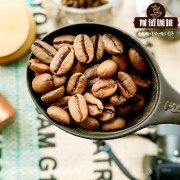Introduction to the Historical Flavor and Taste characteristics of Oaxaca Oaxaca Coffee grown in Mexico Coffee producing area

Professional coffee knowledge exchange more coffee bean information please follow the coffee workshop (Wechat official account cafe_style)
There is no way to grow coffee in the latitude and climate of the north, and coffee growing areas are all in the south. 90 per cent of Mexico's coffee comes from four southern provinces, Chiapas (35 per cent), Oaxaca (13 per cent), Puebla (15 per cent) and Veracruz (25 per cent). A total of nearly 500000 people are engaged in coffee cultivation, 70 per cent of whom are small farmers. Unlike Brazil, almost all coffee cultivation and processing rely on manual labor, and many coffees are organically cultivated. Mexico is one of the world's largest exporters of organic coffee, accounting for 60 per cent of global organic coffee production in 2000. Chiapas and Oaxaca, the two coffee provinces, are the poorest and most aboriginal areas in Mexico, with towering forests blocking traffic, different languages and races, and did not extricate the south from hardship after its colonial liberation from Spain.
Coffee arrived in Mexico very late. In the second half of the 18th century, Spanish immigrants brought coffee trees from Cuba and Dominica in the Caribbean, but it did not really grow coffee commercially until the 1790s, when Germans and Italians emigrated from Guatemala and Central and South America to Mexico, and Veracruz first appeared coffee plantations. Mexico has always maintained the tradition of small farmers. The agricultural reform after the Mexican revolution allowed aborigines and farmers to own small plots of agricultural land and be self-sufficient. The 1970s and 1980s were the golden age of Mexican coffee. In 1973, the Mexican National Coffee Institute (INMECAFE) was established to provide technical assistance to small farmers, loans, guaranteed acquisitions, and even in line with the international market. Coffee output increased, and even increased by 900% in some areas, which improved the social development of remote areas to a considerable extent.
Bananas and coffee are probably the most important economic products for other countries in the Caribbean and Central and South America, while Mexico is extremely rich in minerals. In Spanish colonial times, it was precious metals such as gold and silver, and in modern times it was oil. For Mexico, oil, industry and tourism are far more important than coffee. Coffee growers in the south, mostly aborigines, are usually placed last, and it is the futures prices of London and New York that determine coffee prices on the world market. When the price of coffee is good, profits are monopolized by large multinational exporters, and when the price is not good, it is the farmers who suffer.
Mexico's best coffee producer is Chiapas in the south of the country, where caffeine varieties include Tapanchula and Huixtla. The Oaxaca region also produces high-quality coffee beans, of which the Pluma Coixtepec coffee beans, which are grown in natural conditions, are the best. The Oaxaca region also produces Altura Orisaba (Altura Orizaba) coffee and Altura Vatusco (Altura Huatusco) coffee. The Altura Coata Paike (Altura Coatapec) region produces Veracruz (Veracruz) coffee. The best giant coffee beans in Mexico are Liquidambar MS coffee beans.
OAXACA
Most farmers in the OAXACA producing area own less than 2 hectares (4.4 acres) of land in the area and have several large cooperatives. There are also some larger estates, although some have developed diversified tourism.
Altitude: 900-1700m
Harvest: December to March
Variety: bourbon, Typica,Caturra Maragogype
Qianjie coffee: Guangzhou bakery, the store is small but a variety of beans, you can find a variety of unknown beans, but also provide online store services. Https://shop104210103.taobao.com
Important Notice :
前街咖啡 FrontStreet Coffee has moved to new addredd:
FrontStreet Coffee Address: 315,Donghua East Road,GuangZhou
Tel:020 38364473
- Prev

Costa Rican Brumas processing plant (red honey) Velassa strange species of Costa Rican coffee
Professional coffee knowledge exchange more coffee bean information please follow the coffee workshop (Wechat official account cafe_style) Costa Rica Brumas processing plant (red honey) Verassa strangeness Costa Rica Brumas microprocessing plant (Brumas del Zurqui) in Taiwan's boutique coffee industry almost everyone is familiar with, won the excellent Cup (Cup of Excellen) in 2012
- Next

Honduran Coffee from San Vincent processing Plant, Honduras
Professional coffee knowledge exchange more coffee bean information please follow Coffee Workshop (Wechat official account cafe_style) Product name: San Vincent processing Plant in Honduras Flower Melo small Farmer washing (Honduras San Vicente Juan Contreras Miraflores) production area: Santa Barbara (Santa Barbara) Pena Blanca small Town processing Plant: St. Vincent Office
Related
- Detailed explanation of Jadeite planting Land in Panamanian Jadeite Manor introduction to the grading system of Jadeite competitive bidding, Red bid, Green bid and Rose Summer
- Story of Coffee planting in Brenka region of Costa Rica Stonehenge Manor anaerobic heavy honey treatment of flavor mouth
- What's on the barrel of Blue Mountain Coffee beans?
- Can American coffee also pull flowers? How to use hot American style to pull out a good-looking pattern?
- Can you make a cold extract with coffee beans? What is the right proportion for cold-extracted coffee formula?
- Indonesian PWN Gold Mandrine Coffee Origin Features Flavor How to Chong? Mandolin coffee is American.
- A brief introduction to the flavor characteristics of Brazilian yellow bourbon coffee beans
- What is the effect of different water quality on the flavor of cold-extracted coffee? What kind of water is best for brewing coffee?
- Why do you think of Rose Summer whenever you mention Panamanian coffee?
- Introduction to the characteristics of authentic blue mountain coffee bean producing areas? What is the CIB Coffee Authority in Jamaica?

